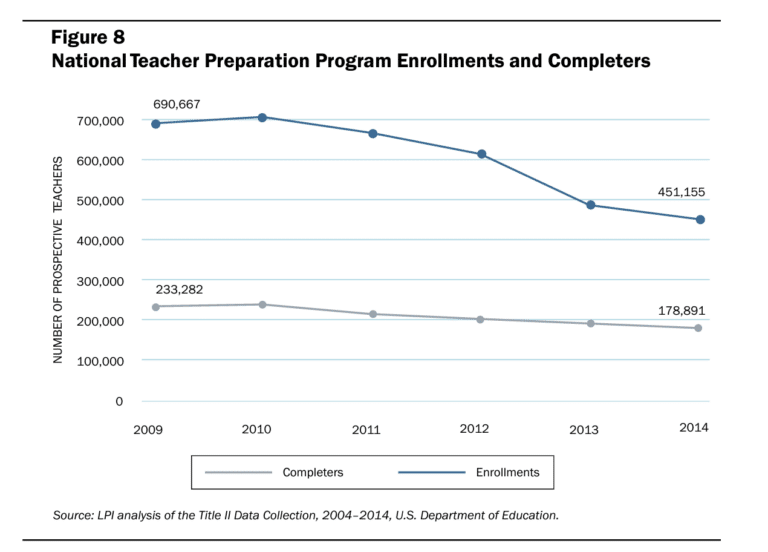


While special education in the US is facing significant roadblocks both in terms of funding and staffing, there are actionable strategies which give us plenty of cause for hope for greater inclusivity and equal educational opportunities in the future.
This article explores the biggest challenges in special education today, examining the complexities that educators, policymakers, and parents grapple with in pursuit of an optimal learning environment for students with disabilities.
The special education landscape: An overview
Let’s examine the overarching challenges in special education today that are garnering the attention of special education directors, leaders, legislators, and caregivers alike.
The staffing shortages that we are seeing can be separated into two issues which are closely related to each other, namely the recruitment and retention of qualified special education teachers and support staff.
There seems to be a general lack of interest in pursuing education as a career path. For instance, only 5% of surveyed students taking the ACT in 2014 reported interest – a 29% decrease from 2010. Moreover, the number of completers in teaching programs dropped 29% from 2009 to 2014:

This has a knock-on effect on the size of the talent pool from which hiring managers at special education schools can choose.
Schools are struggling to fill vacancies, with 86% of US schools expressing that they’re having issues with hiring educators, while another 83% reported challenges in hiring classroom aides, transportation staff, and mental health professionals.
This issue dates back almost 15 years: in the 2010-11 school year, when it was reported that 17% of schools struggled to hire enough special educators as opposed to the 2% who had difficulty filling general teaching positions. This could also be related to the decrease in candidates who have the necessary training and qualifications
Desiree Carver-Thomas, a researcher with the Learning Policy Institute, states that high demands and low pay in special education can lead to high turnover rates, especially when schools resort to hiring individuals lacking the proper training due to a shortage in licensed special education teachers.
This is further evidenced in the “Trends in teacher mobility in Texas and associations with teacher, student, and school characteristics” report, which reveals that 17% to 29% of teaching roles in special education are vacant due to attrition (low wages and lack of qualified staff willing to work under less-than-ideal conditions).
Special education teachers are known for having to manage high levels of stress and pressure on the job. It is therefore crucial that they receive the necessary support and mentorship in order for them to show up to work and thrive.
Researchers Smith and Ingersoll analyzed data from the National Schools and Staffing Survey (SASS) in 2004 and found that having a mentor in the same field reduces the risk of leaving at the end of the first year by 30%.
In the demanding world of special education, burnout is an unfortunate and pervasive reality, impacting both staff wellbeing and student success. This free infographic, tailored specifically for current and aspiring special education leaders, presents a crucial resource in the fight against burnout at every level.

Anyone working in the sector will know that the allocation of both material and human resources has always been one of the biggest challenges in special education.
Despite the increasing number of special education students, federal funding has not met the estimated 40% funding target – in fact, the allocated budget has remained in a steady flatline over the past two decades. This results in schools and districts having to cover the remaining costs themselves, stretching their own budgets rather thin.
One possible reason for this, according to associate professor of educational leadership and policy studies Tammy Kolbe, is that the formula the federal government uses to allocate funds has not been updated for years.
It is therefore not hard to imagine that not all states and districts are able to cover the additional costs for special education services equally. This means that students with the same disability may have access to different levels of support and services depending on where they live rather than on their specific needs. These disparities extend to teaching staff and their paychecks.
Administrative tasks, ranging from complex paperwork to compliance reporting, divert valuable time and energy away from direct student engagement and instructional planning.
In 2023, approximately 73% of school principals and deputy staff reported they spend a large portion of their time on admin, with 64% suffering from stress or burnout as a result.
See how Ori Learning can help you overcome your school or district’s biggest challenges
The intertwined challenges in special education today make providing quality services to children with disabilities somewhat difficult. Recent federal funding increases and state-level initiatives, however, reflect the growing importance of sustainable, long-term strategies to resolve such issues.
Addressing the staffing shortages in special education requires a multi-faceted approach that includes improving the working conditions, providing adequate pay, and offering professional development opportunities for special education personnel.
Over $35 million has been allocated by the U.S. Department of Education to bolster schools’ special education teaching and administrative staff. A significant sum of this grant is allocated for scholarships and other efforts to help students cover the cost of completing special education programs under the Disabilities Education Act.
In recent years, there has been a notable increase in the importance of delivering quality initial teacher education for special education trainees through program initiatives and mentorship opportunities.
The Personnel Preparation program is one such initiative by the US Department of Education aimed at meeting state-identified needs for adequate numbers of fully certified personnel to serve children with disabilities. One of the program’s aims is to foster teacher-faculty partnerships between local institutions and higher education providers to create high-quality mentoring and induction opportunities for trainees.
There is one main driver for the teacher shortages across the country. We suggest 10 different ways you can address it today.

Both federal and state governments are working toward improving their special education budgets. For example, a newly-signed $1.7 trillion federal spending bill has increased funding for special education in the United States for the first time in years, marking a positive step towards addressing funding inequities.
There are also efforts on a state level to provide increased funding for special education, with all 50 states and the District of Columbia recognizing the need for equitable access to resources and support for special education students and staff.
Training solutions like Ori Learning offer a systematic approach to streamline special education services in and outside the classroom. By providing a consistent framework, school principals simplify IEP goal management and compliance regulation, enhance performance with data monitoring, and facilitate ongoing professional staff development.
This failure is largely owed to an inability to attract and retain talented and qualified individuals to the profession due to the unfavourable conditions, namely the long hours and the below-average pay, and also the lack of professional support.
As the federal budget allocated to special education has dwindled for the last 20 years, schools and districts have been forced to cover many of their programs’ running costs themselves, and have subsequently had their budgets stretched thin.
In 2023, the U.S. Department of Education signed a $1.7 trillion federal spending bill, which increased funding for special education for the first time in years, and granted over $35 million to bolster the special education teacher workforce.
The special education landscape in 2023 is multi-faceted. The complexities surrounding workforce challenges, the equitable distribution of funds and resources emphasize the need for long-term, innovative solutions which can lead to long-lasting change.
Upgrade your district or school’s special education program with Ori Learning’s transition curriculum – a research-based solution informed by various frameworks to shape learning and instructional approaches.
Receive custom support backed by rich industry experience that can help you tackle your strategic goals at scale. Request a free demo of our platform to experience first-hand its powerful accommodation and translation features, automated reporting tools, and intuitive design.

